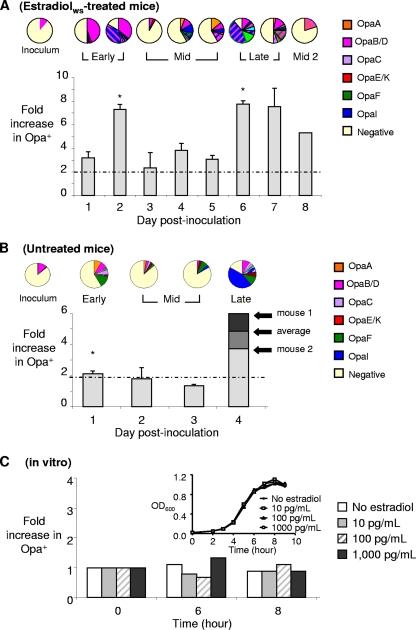FIG. 1.
For both estradiol-treated and untreated mice there was cyclical recovery of Opa+ variants, and estradiol does not select for Opa protein expression in vitro. For mice treated with 17β-estradiolws (A) or not treated with estradiol (B) there was cyclical recovery of Opa+ variants after the mice were inoculated with a defined suspension containing predominantly Opa− variants. The average fold increases for Opa+ variants among vaginal isolates compared to the inoculum are indicated in the histograms, and selection was defined as a ≥2-fold increase (dotted line). The bars indicate standard errors of the means; the asterisks indicate that the P value is <0.03 for a comparison with the value for the middle phase, which was defined as days 3 to 5 for panel A and as day 3 for panel B. The results in panel A are the results of one experiment performed with 6 mice inoculated with 89% Opa− and 11% OpaB variants and are representative of two independent experiments (5 or 6 mice per experiment). The data in panel B are combined data from three experiments in which untreated mice were colonized for 1 to 4 days. The average fold increase was based on the results for 11 mice on day 1, for 5 mice on day 2, for 3 mice on day 3, and for 2 mice on day 1. In each panel the pie charts show the Opa phenotype of a representative mouse, and the colors indicate the different Opa proteins of strain FA1090. The striped patterns show the results for variants that express multiple Opa proteins. (C) Recovery of Opa+ isolates from a liquid culture at different stages of growth, expressed as fold increases compared to the inoculum. GCB with no estradiol or with 10, 100, or 1,000 pg/ml 17β-estradiolws was inoculated with a bacterial suspension that contained 75% Opa− variants. Concentrations were based on serum estradiol levels in untreated, pellet-treated, and estradiolws-treated mice (56). The Opa phenotypes of 96 colonies (zero time) and 36 colonies (6 and 8 h) isolated from each culture at different time points were determined, and the fold changes compared to the inoculum are indicated. No change in the Opa phenotype was observed under any conditions. OD600, optical density at 600 nm.

